02.08.2010: I have probably done the craziest flying of my life over the last few days, unfortunately only as a passenger. First I flew to New Your for a few days, then from there to San Francisco for two days, and then back to Zurich, only to continue on the following day via Singapore to Sydney, from where I will return probably at the end of this week. I definitely get more hours flying as a passenger on commercial airlines than flying myself. That gives a total of around 67 flying hours in two weeks, with the cruising speed of the SportCruiser that would would mean around 300 flying hours…
There were however at least two highlights during that journey, or rather odyssey. The first one was from San Francisco to Zurich, where I flew with the Swiss A340-300 with the crazy “Let’s go to San Francisco” livery. Even my business partners from San Francisco knew about it, one of them even drove with his son to the airport to take pictures. They really landed a publicity coup with it. I was wondering whether the crew would also be dressed up in hippie style, but that was not the case.
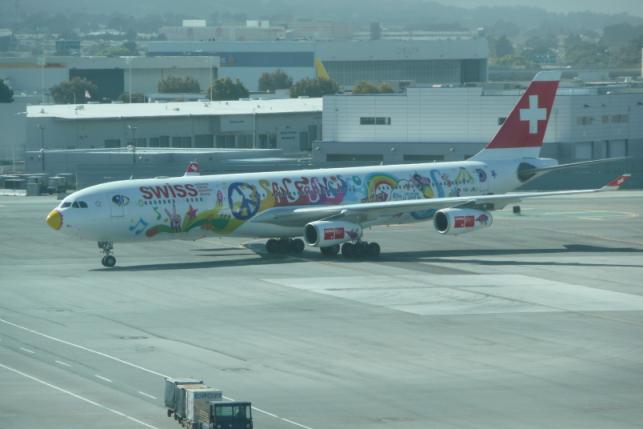
Then I flew for the first time with the Airbus A380 from Zurich to Singapore. Unfortunately it was parked in a way that it was difficult to see from the gate, I just managed to take a picture through some blinds of a window. The thing is really huge inside, even the upper level, were I flew, is about the size of the cabin of the A340-300 (228 seats). There were 454 passengers onboard, which meant practically full, as Singapore Airlines has a fairly generous seating arrangement (471 seats). The other operators all put more seats in (Emirates 489, Lufthansa 525, Air France 538), only Quantas has slightly less seats (450).

Anyway, last week I sent all the papers to the Swiss Federal Office of Civil Aviation. In the meantime I received the insurance documents, so I hope that when I am back home I have the permit to start test flying on my table. If the weather improves then I might do it somewhere over the next two weeks, but definitely before the end of August.
12.08.2010: When I returned from Australia last Sunday I was disappointed to see that the permit to fly for our SportCruiser had not arrived from the Swiss Federal Office of Civil Aviation (FOCA) . Just to be sure I had a look at the online aircraft registry (http://www.bazl.admin.ch/fachleute/luftfahrzeugregister/index.html?lang=en), and there I saw that our SportCruiser HB-YNL had been registered, but with some completely wrong data.
To correct this I called the FOCA, but instead of taking my comment they told me that some information was missing in our application file, which meant they could not complete the registration and issue the permit to fly. Three days and about 25 phone calls later (with various employees of the FOCA, of the Experimental Aviation Association and with other builders), the conclusion was that nothing was missing that they had told us to deliver: The problem was that since about a month they require Form 21 and Form 18b (application for a permit to fly), but they neither list that as a requirement on their list of required deliverables, nor do they tell you that they need it. They just wait! On top of that some of the key persons involved in issuing permits to experimental aircraft are on vacation.
After some more phone calls with some more FOCA employees they agreed to issue the permit to fly today if I send them the two forms by email, which I of course immediately did. And indeed, only 20 minutes after I had sent the last document the permit arrived!
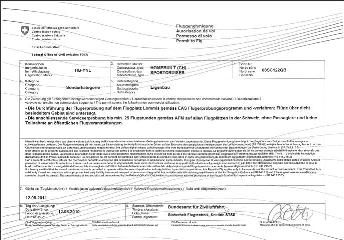
That means that I can probably make the first flight sometime next week (if I don’t have to go abroad again…).
15.08.2010: Today I only spent about an hour at the airport, as I was preparing the documents for the first flight. I managed however to install the canopy seal, as well as to fix some other minor issues. I am slowly getting ready for the first flight, which will hopefully take place later next week..
16.08.2010: I finished my conversion training today on the clubs factory built SportCruiser HB-WYC. Unfortunately (or maybe it’s the opposite) we had 15 knots wind with five to ten knots gust, and from around 45 degrees off the centre line, so I had to work quite a bit. However the landings went surprisingly well. The last three were even perfectly smooth, which was quite surprising considering the conditions. It helps in such turbulence to only use 20 degrees flap and to land with quite some power, the plane is a lot more stable like that. As I have seen the weather will improve during the week, which is good as a first flight under such conditions is out of the question.
17.08.2010: Today I finished the last open items, such as installing the strobe covers. Here the result, with the three LEDs on the left side acting as strobes, and the three on the right side as position light.
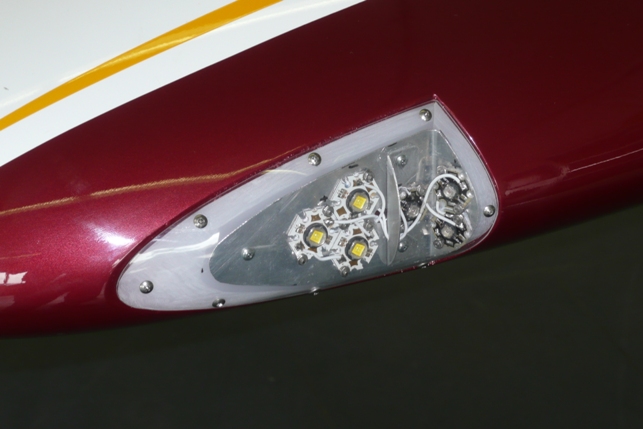
Here also a picture of the completed cockpit, with the seats installed.
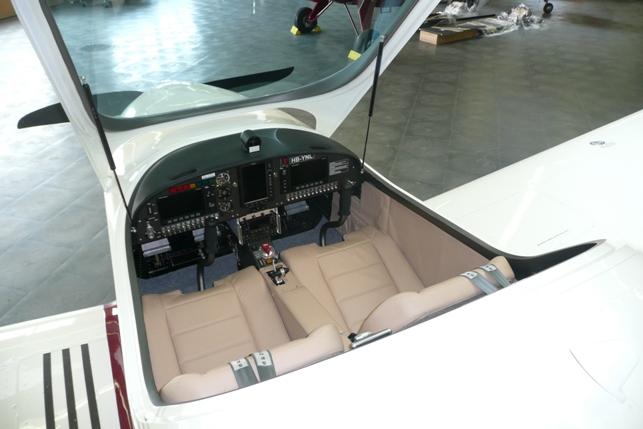
I then started with the preparations for the first flight, which included a thorough check of the whole plane. I moved it outside to perform some taxi tests, when the SportCruiser of our club returned from some conversion training. This gave me the chance to take some pictures with both planes side by side.


The weather was quite bad in the morning, with occasional showers and a gusty wind (15/25 kts), but later in the afternoon it started to get calmer. I therefore decided to give it a try.
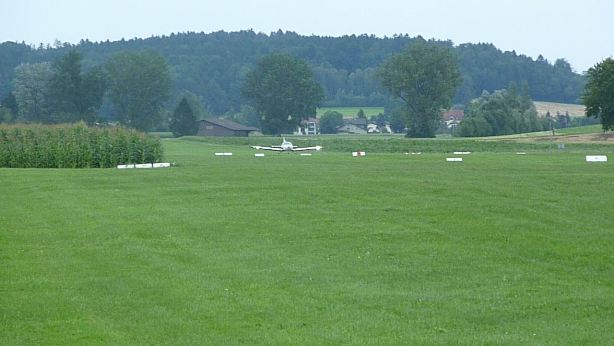

And here it is:
HB-YNL got airborne for the first time on the 17th August 2010 at 17:05 local time in Lommis (LSZT) !
The first flight was totally smooth, the plane just flew as it should. I made some circuits overhead to stay within gliding distance of the airfield, but luckily that precaution proved not to be necessary. The first landing went as smoothly as the ones I did yesterday.
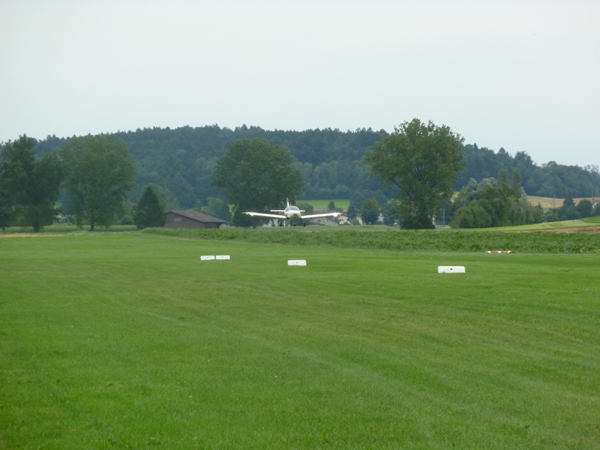
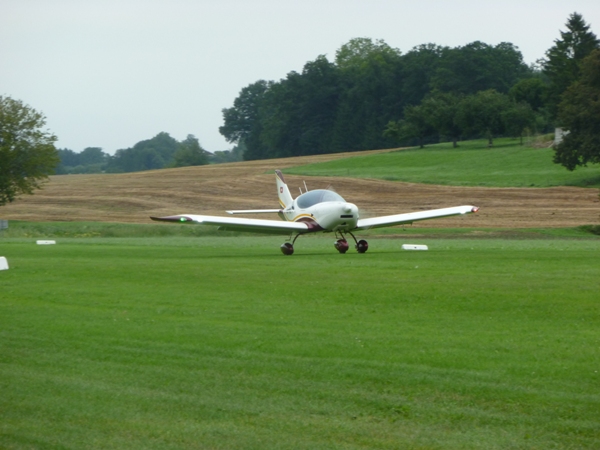
I immediately did another flight of about twenty minutes, and again without any problems. Only the backup ASI did not function on both flights, I will have a look at it tomorrow.
It is really great fun to fly the plane Rolf and I have built ourselves. Let’s hope I manage to do the flight testing as quickly as possible to start travelling soon.
I am quite tired after today’s “action”, so more details tomorrow.
| Flight | Flight duration | Landings | Remarks |
| 1 | 0:19 | 1 | First Flight |
| 2 | 0:21 | 1 | |
| Total | 0:40 | 2 |
18.08.2010: It really feels great to arrive at the airport and seeing a plane, rather than a project. Cool.
I had a look at the UMA backup ASI this morning, and indeed there is something broken inside. It remains at 0 knots until the speed is around 160 kts and then jumps with a mechanical sounding noise to a random speed around 50 to 100 kts. I called CzechSportAircraft and they told me they would send me a replacement free of charge, later I got an email that FEDEX has picked up the parcel in Kunovice. I should receive it tomorrow, so I will be flying again by Saturday or Sunday. That’s really great service.
That meant of course that I could not do my first test flights, as they are for calibrating the air speed indicators, and it does not really make sense to do that twice.
My daughter took two videos of my fist flight (takeoff and landing), but unfortunately they are in high resolution, so around 100 MB each. That’s too big to post here, but I will try to convert them to a lower resolution. Here however some additional pictures from yesterday’s first flight:
Here I am getting ready for the first flight. I had to wait for the whole afternoon for the wind to calm down, which finally happened towards 17:00 local time.

The canopy is closed, now it’s for real. I was amased the difference it makes to sit in the plane one has build himself compared to a factory built plane. One finds each switch immediately, everything is known and familiar. That’s a lot easier than in a factory built plane, where one first has to get accustomed to the layout.

I did some taxi tests in the morning, so nothing special here. I first thought that the plane has a tendency to turn left, but our taxiway has a slight slope to the left and with an fully castering nose wheel the plane just follows the slope. Some brake application is therefore necessary.
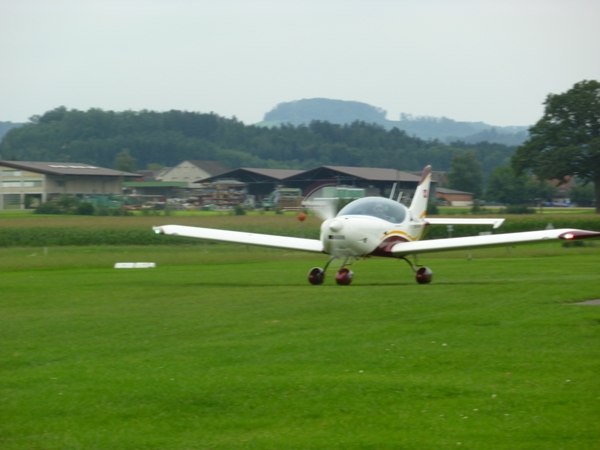

Lining up on runway 24, the LED landing lights are really as bright as we have hoped.
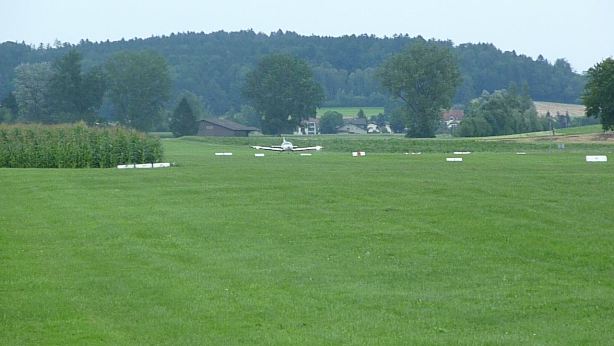
Our runway is a bit bumpy, so full elevator helps during the initial ground roll, but one has to be careful with the SportCruiser as the elevator is quite sensitive and should be neutral during liftoff. Also the liftoff speed is reached very quickly, takeoff roll was an estimated 200 m.

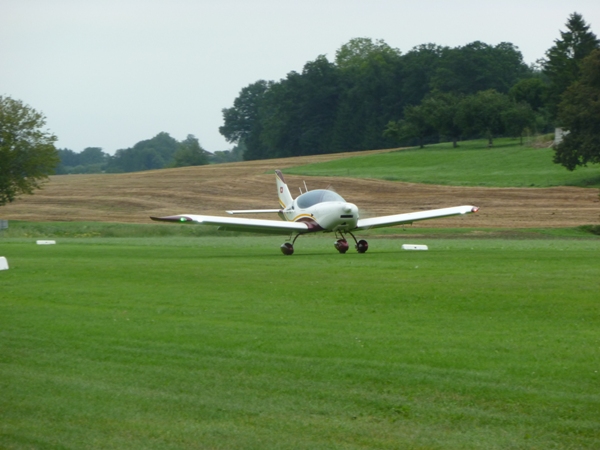

There were a few knots of wind and from about 45 degrees, so some aileron was required to counter that. Once higher up the plane flew however nicely straight. A bit of right rudder is required, but I will correct that by tightening the respective spring in the rudder linkage. The factory plane behaves exactly the same.

Here the approach for the first landing.

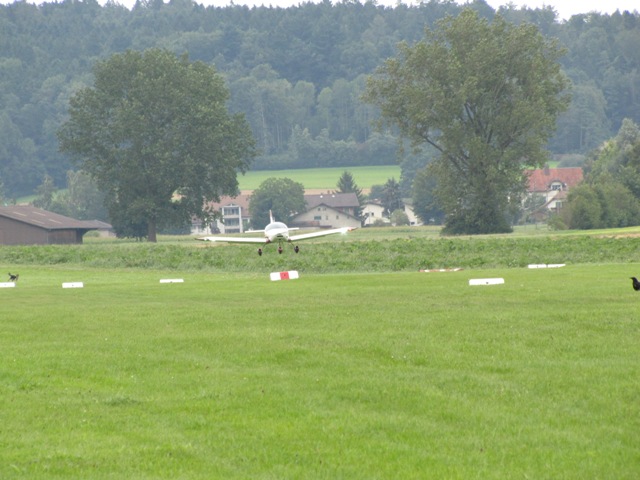
Again, ground roll was probably around 200 m with little or no braking.

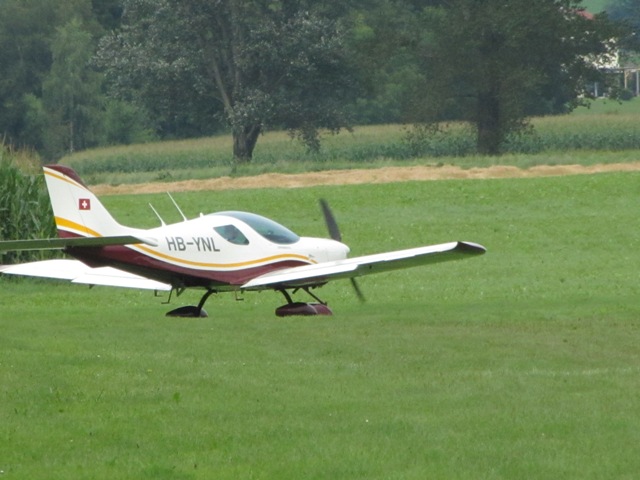

20.08.2010: The replacement analogue ASI arrived yesterday from CzechSportAircraft. That’s really what I call perfect service, I had a replacement on my desk free of charge within 24 hours after I called. I was at work, however, so I only installed it this morning and then did the ground calibration again.
A short check flight confirmed that it works perfectly. Here some impressions from that flight. Visibility from the SportCruiser cockpit is just great compared to e.g. a Piper Archer, and even compared to the Robin, as it is not obstructed by a roof or window frames.
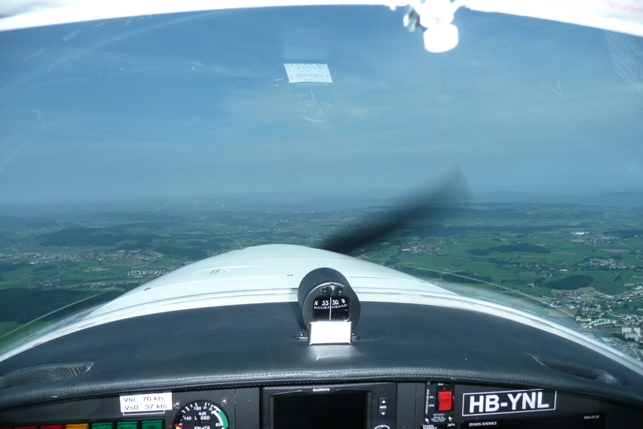
Silvan recommended that I install the sun shade before future flights, as the weather is improving again, and that was a great advice. It can get really hot under the all glass canopy without it. The shade can be pulled out and pushed back in a second
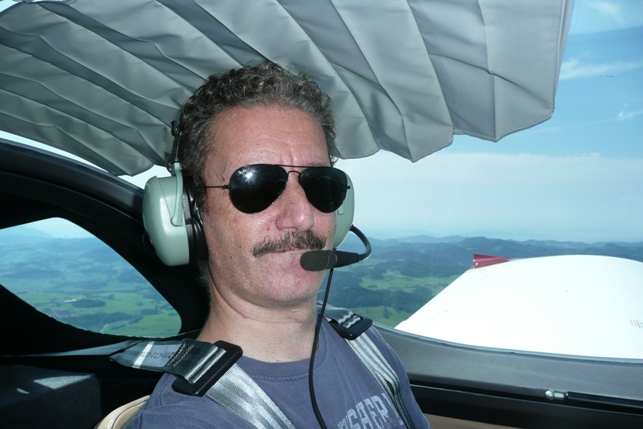
In the afternoon I did the first test flights of the EAS test flight program (calibration of air speed measurement) with my wife as test engineer. She loved the plane and the view, I really hope we will use it a lot for travelling in the future.
For the first time I noticed the effect of having increased he MTOW to 630 kg. The fest flights have to be performed at or near MTOW, so with my wife and myself and full fuel and my flight bag I still needed 25 kg of ballast. Fortunately we have lead bags in the workshop, so I put two of them into the baggage lockers in the wings.
I now have to send the test results to the EAS for acceptance before proceeding with the next measurements. I can however already say that the measurements are ok, as the EAS developed an Excel sheet into which the data and all environmental parameters are inserted, and it then calculates the errors automatically.
| Flight | Flight duration | Landings | Remarks |
| 3 | 0:27 | 2 | ASI check flight |
| 4 | 0:44 | 1 | EAS test flight 1 |
| 5 | 0:22 | 1 | |
| 6 | 0:20 | 1 | |
| Total | 2:33 | 7 |
To top off the already successful day the Patrouille Suisse, the demonstration team of the Swiss Air Force did a rehearsal for an upcoming event over Frauenfeld, the city where I live. Here an impression of one of their low passes in the evening light.

21.08.2010: The annual meeting of the EAS took place this weekend in Mollis, which lies only about half an hour of flight south of Lommis (sometimes people mix them up due to the similarly sounding names). I even have Mollis on the list of permitted airfields for the test period, as it has a hard surface runway, but I decided to go there by car. Six flights are in my opinion just not enough experience to go somewhere else with my SportCruiser yet.

The meeting was organised by the EAS together with the Swiss Microlight Flyers and there were around 85 planes attending, including quite a few from Italy, Austria, Czech Republic, Germany, Denmark, the UK and France.
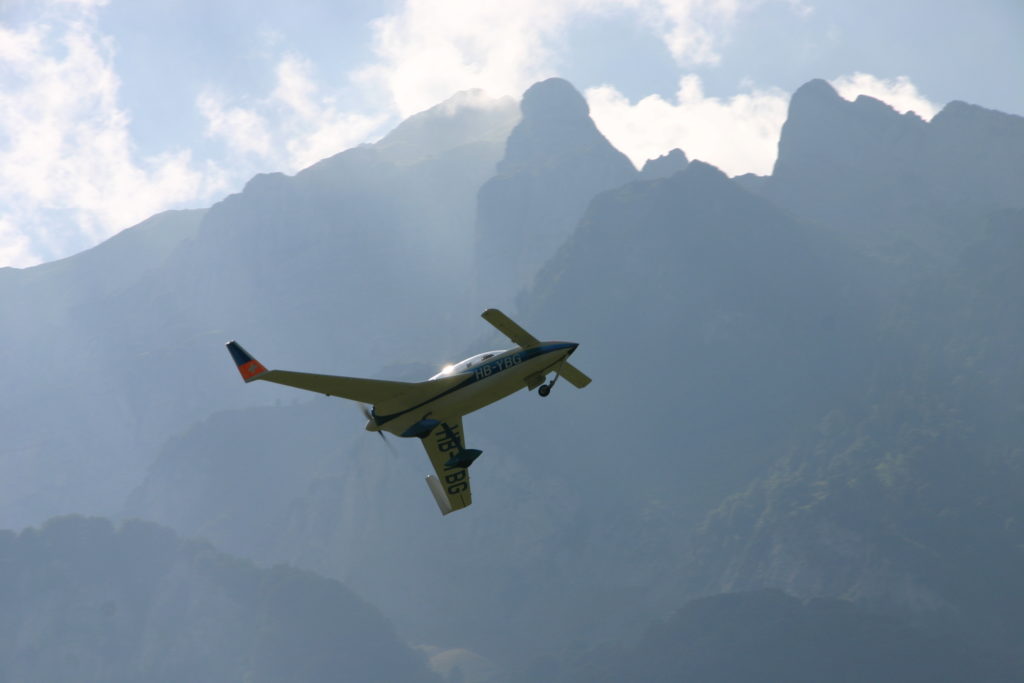
After the evening dinner I received a very nice Certificate of Achievement from the EAS, together with some flowers and a bottle of champagne, for having completed and flown my plane. It really is a great feeling to have reached the end of quite an intensive time. Even though the SportCruiser is an excellent kit we still spent around 1’700 hours building it, and that’s only the hours in the workshop. Together with all the preparations, reading manuals, planning, drawing schematics, doing paperwork etc. we have probably spent around 2’500 hours over 2 1/2 years.
22.08.2010: Today the weather was very nice again, so I needed an excuse to go flying. As the airspeed calibration flight of two days ago was done in fairly bumpy weather I decided to do it again. I anyway have to perform 25 hours of test flying near the home airfield, so it didn’t really matter. My wife was busy, so my older daughter joined me to do the writing. She was not previously registered as permitted flight crew during the test flight period, but I met the chief of flight testing yesterday in Mollis and he approved adding her to the list.
We took off very close to the maximum takeoff weight (MTOW) of 630 kg, this time with full fuel and more than 40 kg of ballast. I am amazed how well the plane handles even at MTOW. The take-off run is maybe 50 m longer than at the much lower weight of the first flights (solo, only 2/3 fuel and no baggage), but still only around 200 m, and that on our bumpy grass runway and with an air temperature of 33 degrees Celsius. Also the climb rate is still very good under these conditions. It took us around 50 minutes to perform the calibration flights (four to six different speeds each in takeoff, cruise and landing configuration and all in two directions against and with the wind).
As the permitted landing weight is only 600 kg we had to burn off some fuel (no fuel dump like the airliners) to get down to that weight before landing (not that it would not be possible, it’s more of a legal issue), so we just cruised around a bit, having a look at the mountains and chasing some of the many hot air balloons that were in the air. We also met a glider and helicopter, and both times the FLARM collision warning device gave an indication when the distance was around 2.5 km. Excellent, as both types of aircraft can be difficult to spot.
Here the total flying hours so far:
| Flight | Flight duration | Landings | Remarks |
| 7 | 1:20 | 1 | EAS test flight 1, 2nd time |
| Total | 3:53 | 8 |
In Switzerland all experimental aircraft need a noise certificate, with fairly stringent noise limits imposed. The EAS organises two measurement campaigns each year, and the next and last one in 2010 takes place on the 11. September. I really want to make it at that date, as the noise certificate is required to receive the final, unrestricted permit to fly. Until then I still have to perform at least the best angle of climb speed / rate of climb speed test flight (EAS test flight 2), climb rate test flight (EAS test flight 3 an the stall speed test flights (EAS test flights 4 and 5). I am off now for two weeks to the US, but I am back on the 4th September. That gives me a week, so let’s hope for good weather.